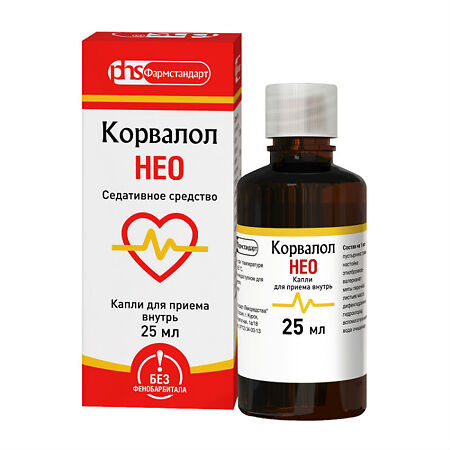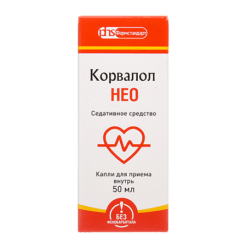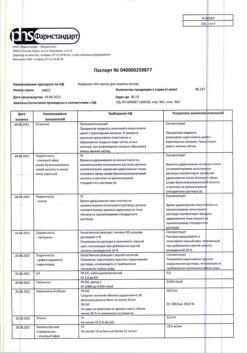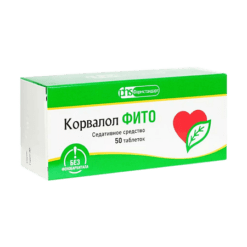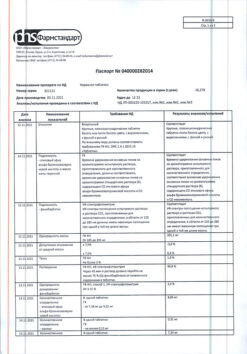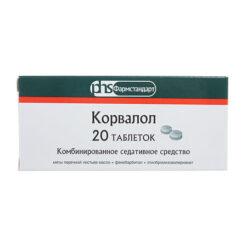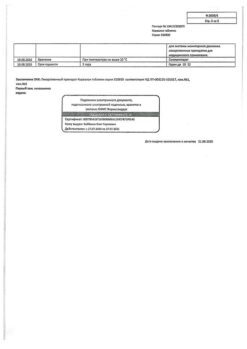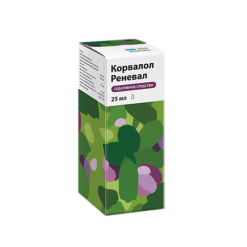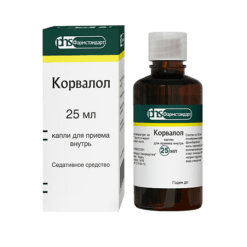No products in the cart.
Corvalol Neo, drops 25 ml
€1.00
Out of stock
(E-mail when Stock is available)
EAN: 4601669008633
SKU: 440099
Categories: Medicine, Neurology and Psychiatry, Sedatives and hypnotics
Description
Sedative.
A combined preparation, the action of which is caused by the properties of its constituent substances. It has sedative and antispasmodic effects, moderate cardiotonic effect (slows the rhythm and increases the force of heart contractions), has moderate hypotensive properties.
Ethylbromisovalerianat has sedative and antispasmodic effect caused by irritation, mainly of receptors in the oral cavity and nasopharynx, reduction of reflex excitability in central nervous system and increased inhibition in cortical and subcortical structures of the brain, as well as decreased activity of central vasomotor centers and direct local spasmolytic effect on smooth muscles. By the nature of its action is similar to valerian drugs.
The herb motherwort has a marked sedative effect (sedative), moderately reduces the frequency and increases the force of heart contractions, shows moderate hypotensive properties.
Pearmint oil has reflex vasodilatory, antispasmodic, mild choleretic, antiseptic action. The mechanism of action is related to the ability to irritate the “cold” receptors of the oral mucosa and reflexively dilate mainly vessels of the heart and brain. It eliminates the phenomena of flatulence by irritating the mucosal receptors of the gastrointestinal tract (GIT), increasing intestinal peristalsis.
Diphenhydramine is a first generation blocker of H1-histamine receptors. Its action on the central system is due to blockade of H1-histamine receptors of m-cholinoreceptors in the brain. It reduces or prevents histamine-induced smooth muscle spasms, increased capillary permeability, tissue edema, itching and hyperemia, has antiemetic and sedative effects, and has a sedative effect. Antagonism with histamine is shown more in relation to local vascular reactions than to systemic ones, i.e. reduction of blood pressure.
Indications
Indications
Active ingredient
Active ingredient
Composition
Composition
Composition per 100 ml
Active ingredients:
The tincture of motherwort herb – 720.00 mg;
ethylbromisovalerianate – 20.00 mg;
/p>
Peppermint leaf oil – 1.42 mg;
diphenhydramine hydrochloride – 1.00 mg.
Auxiliary substances:
Purified water – up to 1 ml.
How to take, the dosage
How to take, the dosage
Take orally, before meals, 3 times a day, 30 drops dissolved in a small amount (30-40 ml) of water. Shake the bottle before use.
The course of treatment is 10-15 days. On the recommendation of the doctor may be repeated course of treatment, but not earlier than 1 month.
Interaction
Interaction
The simultaneous use of the drug Corvalol Neo with ethanol and drugs depressing the central nervous system (sedatives, hypnotics, neuroleptics, tranquilizers, tricyclic antidepressants) may mutually enhance the effects.
Moamine oxidase inhibitors (MAOIs) increase the severity and duration of anticholinergic effects of diphenhydramine. Corvalol Neo should be taken together with MAO inhibitors with caution or 2 weeks after their withdrawal.
Diphenhydramine may increase the anticholinergic effects of other drugs (atropine, tricyclic antidepressants).
Antagonistic interaction is noted in co-administration with psychostimulants.
Diphenhydramine is an inhibitor of cytochrome P450 isoenzyme CYP2D6. Thus, Corvalol Neo may potentially interact with drugs whose primary metabolism is carried out by CYP2D6.
Corvalol Neo increases the effect of antispasmodic, analgesic drugs.
Alcohol increases the effect of the drug and its toxicity.
Limits the effectiveness of apomorphine as a vomiting agent in the treatment of poisoning.
Special Instructions
Special Instructions
There is no experience of using the drug in children under 18 years of age, in pregnancy and during breast-feeding.
Wave exposure to UV radiation and ingestion of ethanol should be avoided during the use of the drug.
Long-term use of the drug in high doses is not recommended because of the possible development of overdose.
Because of the possible toxic effect of bromine cumulation in the body, long-term use at high doses is not recommended.
The physician must be informed about the use of this medication: the antiemetic effect may make it difficult to diagnose appendicitis and to recognize the symptoms of overdose with other medications.
Corvalol Neo contains 47.5% ethanol, so if administered orally, the maximum single dose of the drug has 0.308 g of absolute ethanol (ethanol), and in maximum daily dose – 0.923 g.
Impact on the ability to drive vehicles and mechanisms:
Due to the possibility of dizziness, reduced concentration and other side effects associated with taking the drug, during the treatment period, patients are advised to refrain from driving and engaging in other potentially dangerous activities requiring increased concentration, rapid psychomotor and motor reactions.
Contraindications
Contraindications
– hypersensitivity to the components of the drug;
– severe renal and/or hepatic impairment;
– closed angle glaucoma;
– prostatic hyperplasia;
– bladder neck stenosis;
p> – bronchial asthma;
– epilepsy;
– pregnancy;
– period of lactation (breastfeeding);
– childhood under 18 years of age (efficacy and safety not established);
– porphyria;
– pyloroduodenal stenosis;
– erosive-ulcerative lesions of the gastrointestinal tract (in the acute phase);
– stenotic peptic ulcer disease of the stomach and duodenum.
With caution:
– liver disease
– impaired renal function
– glaucoma
– urinary retention
– bronchitis
– chronic obstructive pulmonary disease.
In prolonged use, resistance may develop. the drug may potentiate the effects of alcohol, so the use of alcohol during treatment should be avoided.
Application in combination with other drugs with antihistamine action, including topical medications, cough and cold remedies, should be avoided.
Side effects
Side effects
Side effects are more common in elderly patients. Use in elderly patients with confusion should be avoided.
Diphenhydramine may aggravate existing tinnitus.
Corvalol Neo contains ethyl alcohol (see section “Cautions”); therefore, the drug should be used with caution in alcoholism, as well as in high-risk patients, including those with liver disease, brain injury, and brain disease.
If you have any of the above diseases/conditions, be sure to consult a physician before taking this medication.
Blood and lymphatic system disorders: hemolytic anemia, thrombocytopenia, agranulocytosis.
Immune system disorders: allergic reactions, including rash, urticaria, difficulty in breathing, Quincke’s edema.
Skin and subcutaneous tissue disorders: photosensitivity.
Mental disorders: confusion, paradoxical agitation (elderly patients are particularly susceptible); in some cases irritability, euphoria.
Nervous system disorders: drowsiness, weakness, decreased psychomotor reactions, impaired coordination and reaction time, fatigue, dizziness, decreased ability to concentrate, unsteadiness, seizures, headache, paresthesias, dyskinesia; in some cases insomnia, tremor.
Visual disorders: blurred vision.
Hearing and labyrinth organ disorders: ringing in the ears.
Cardiovascular system disorders: decreased blood pressure, slowed heart rate, tachycardia, extrasystole.
Respiratory system disorders, thoracic and mediastinal organs: dry mucous membranes of the nasal cavity, bronchi (thickening of bronchial secretion).
Gastrointestinal tract: dry mouth, dyspepsia, nausea, vomiting, discomfort in the epigastric region, anorexia.
Muscular, skeletal and connective tissue disorders: muscle twitching.
River and urinary tract disorders: difficulty in urination, urinary retention.
The above phenomena disappear with reduction of the drug dose or discontinuation of the drug. With long-term use of high doses of the drug it is possible to develop drug addiction as well as bromine accumulation in the body and development of bromism which manifestation are: depressed mood, apathy, rhinitis, conjunctivitis, hemorrhagic diathesis, movement coordination disorders.
If any of the side effects listed in the instructions worsen, or if you notice any other side effects not listed in the instructions, tell your doctor.
Overdose
Overdose
Symptoms:
Depression of central nervous system function, agitation or depression, dilated pupils, dry mouth, gastrointestinal paresis, fever, flushes, tremors, dystonic reactions, hallucinations and ECG changes. Significant overdose can cause rhabdomyolysis, seizures, delirium, toxic psychosis, arrhythmias, coma and cardiovascular failure.
Treatment in overdose:
There is no specific antidote.
Gastric lavage. If necessary – symptomatic treatment: drugs that increase blood pressure, oxygen, intravenous administration of plasma exchange fluids.
Epinephrine and analeptics should not be used.
In case of symptoms of overdose, the use of Corvalol Neo should be stopped and the patient should immediately consult a physician.
Pregnancy use
Pregnancy use
Additional information
| Shelf life | 2 years. Do not use after the expiration date stated on the package. |
|---|---|
| Conditions of storage | Store at a temperature not exceeding 25 ° C. Store out of the reach of children. |
| Manufacturer | Pharmstandard-Leksredstva, Russia |
| Medication form | oral drops |
| Brand | Pharmstandard-Leksredstva |
Other forms…
Related products
Buy Corvalol Neo, drops 25 ml with delivery to USA, UK, Europe and over 120 other countries.

